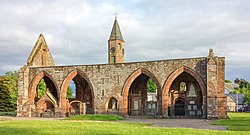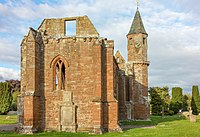Fortrose Cathedral
| Fortrose Cathedral | |
|
Ross-shire | |
|---|---|
 Ruins of Fortrose Cathedral | |
| Type: | Former cathedral |
| Location | |
| Grid reference: | NH72715653 |
| Location: | 57°34’51"N, 4°7’50"W |
| Village: | Fortrose |
| History | |
| Built c. 1200 | |
| Former cathedral | |
| Late Gothic | |
| Information | |
| Owned by: | Historic Scotland |
| Website: | Fortrose Cathedral |
Fortrose Cathedral is a roofless ruin at Fortrose, a village on the shore of the Black Isle, and within Ross-shire. In its day though 'the Church of Saint Peter and Saint Boniface of Fortrose', was the episcopal seat (cathedra) of the mediæval Diocese of Ross.
Today the cathedral is in the care of Historic Environment Scotland.
History
It is probable that the original site of the diocese was at Rosemarkie, the next village to Fortrose, but by the 13th century the canons had relocated a short distance to the south-west, to the site known as Fortrose or Chanonry. According to Gervase of Canterbury, in the early 13th century the cathedral of Ross was manned by Céli Dé (culdees).
The cathedral had twenty-one prebends involving the income of thirty-one churches, the income of which was divided between the bishop and various members of the cathedral chapter by office, so that it was the centre of a feudal web of estates.
The south-eastern chapel, aisle and porch were commissioned by Euphemia I, Countess of Ross in the late 14th century, but likely replaced an earlier building. These parts of the cathedral resemble work at Elgin Cathedral from the same period, something that can be attributed to the fact that its bishop Alexander de Kylwos had earlier been Dean of Moray.
After Reformation, the church it continued to be used as a church for the town.[1] It began to fall apart in the later 16th and early 17th century, though the sacristy and chapter house were still used for local gatherings of officials in the 18th century.[1] Like other Scottish ex-cathedrals, its grounds remained in use as a graveyard.[1]
The government took over responsibility for its care in 1851[1] and it is now a scheduled monument.[2]
Building

The cathedral was constructed primarily of red sandstone.[1] Two sections, the chapter house and the nave's south aisle, still stand on location. The outline of the remainder of the cathedral complex was revealed by excavations in 1873. The cathedral building appears to have begun, probably in the early-to-mid-13th century, as an "extended rectangle" with a tower in the north-west, and a chapter house and sacristy north of the choir.
The south aisle, which contains two distinct chapels, has several burials. The eastern chapel is thought to contain burials of Countess Euphemia and Bishop Robert Cairncross. The tomb in the western chapel is, reputedly, Bishop John Fraser. Alexander of Islay, Earl of Ross and Lord of the Isles, was buried in the cathedral, but the location is not known. On the ceiling of the western chapel there are two heraldic bosses, representing Earl Alexander and Bishop John Bulloch.
Outside links
| ("Wikimedia Commons" has material about Fortrose Cathedral) |
- Fortrose Cathedral: Historic Environment Scotland
References
- ↑ 1.0 1.1 1.2 1.3 1.4 Fortrose Cathedral
- ↑ Fortrose Cathedral - scheduled monument detail (Historic Environment Scotland)
- "Fortrose Cathedral", Historical Scotland Property Details, historic-scotland.gov.uk, http://www.historic-scotland.gov.uk/propertyresults/propertydetail.htm?PropID=PL_137&PropName=Fortrose%20Cathedral, retrieved 14 September 2010
- Alston, David (1999), Ross and Cromarty: A Historical Guide, Birlinn, ISBN 1-874744-48-3
- Anderson, Alan Orr, ed.: 'Scottish Annals from English Chroniclers A.D. 500 to 1286' (Paul Watkins, 1908; 1991 revised & corrected edition) ISBN 1-871615-45-3
- Cowan, Ian B.; Easson, David E. (1976), Mediæval Religious Houses: Scotland With an Appendix on the Houses in the Isle of Man (2nd ed.), Longman, ISBN 0-582-12069-1
- Cowan, Ian B. (1967), The Parishes of Mediæval Scotland, Scottish Record Society, vol. 93, Neill & Co.
- Fawcett, Richard (1997), Scottish Cathedrals, Historic Scotland, ISBN 0-7134-8188-9
- Fawcett, Richard (1985), Scottish Mediæval Churches: An Introduction to the Ecclesiastical Architecture of the 12th to 16th Centuries in the Care of the Secretary of State for Scotland, Her Majesty's Stationery Office, ISBN 0-11-492385-X
- D. E. R. Watt (1991), Ecclesia Scoticana, Series episcoporum ecclesiae Catholicae occidentalis ab initio usque ad annum mcxcviii ... Series 6, Britannia, Scotia et Hibernia, Scandinavia. Tom. 1 (ediderunt Odilo Engels et Stefan Weinfurter ; cooperante H. Kluger ... B.E. Crawford), Anton Hiersemann, ISBN 3-7772-9116-1
